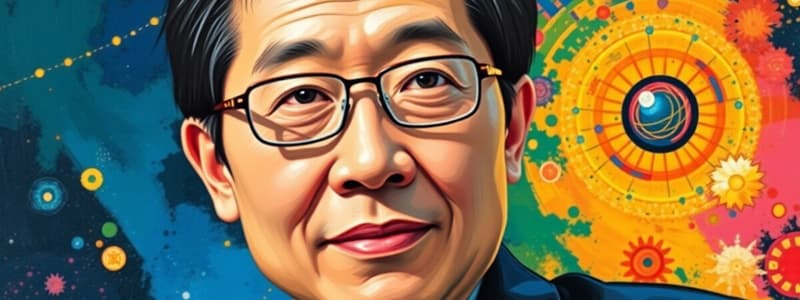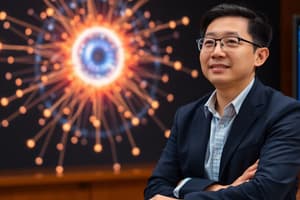Podcast
Questions and Answers
What fundamental principle did Yang Chen-Ning challenge in his research?
What fundamental principle did Yang Chen-Ning challenge in his research?
- The theory of relativity
- The law of conservation of parity (correct)
- The uncertainty principle
- The law of conservation of energy
With whom did Yang Chen-Ning collaborate to question the conservation of parity?
With whom did Yang Chen-Ning collaborate to question the conservation of parity?
- Tsung-Dao Lee (correct)
- Shiing-Shen Chern
- Chien-Shiung Wu
- Robert Mills
Which significant award did Yang Chen-Ning receive in 1957?
Which significant award did Yang Chen-Ning receive in 1957?
- The Nobel Prize in Physics (correct)
- The Fields Medal
- The World Science Award
- The Templeton Prize
What was the outcome of the experiment suggested by Yang and Lee?
What was the outcome of the experiment suggested by Yang and Lee?
What theory did Yang propose in 1954 alongside Robert Mills?
What theory did Yang propose in 1954 alongside Robert Mills?
What major theoretical contribution did Yang Chen-Ning propose alongside Robert Mills?
What major theoretical contribution did Yang Chen-Ning propose alongside Robert Mills?
In which year did Yang Chen-Ning leave China to study at the University of Chicago?
In which year did Yang Chen-Ning leave China to study at the University of Chicago?
What was a significant outcome of Yang Chen-Ning's research with Tsung-Dao Lee?
What was a significant outcome of Yang Chen-Ning's research with Tsung-Dao Lee?
Which experiment was carried out to test Yang and Lee's proposal regarding the law of conservation of parity?
Which experiment was carried out to test Yang and Lee's proposal regarding the law of conservation of parity?
What position did Yang Chen-Ning hold at Stony Brook University in 1965?
What position did Yang Chen-Ning hold at Stony Brook University in 1965?
Flashcards are hidden until you start studying
Study Notes
Yang Chen-Ning's Life and Work
- Yang Chen-Ning was a Chinese-born theoretical physicist who revolutionized particle physics.
- He won the Nobel Prize in Physics for his work in 1957.
Key Contributions to Physics
- Yang challenged the accepted law of conservation of parity.
- He proposed that this law did not hold true for certain "weak interactions", such as radioactive decay.
- He worked with Tsung-Dao Lee to prove the conservation of parity was not always true.
- This led to a new understanding of particle interactions at the subatomic level.
- Yang and Lee proposed an experiment to test their hypothesis, which Chien-Shiung Wu successfully conducted.
- Yang also proposed the Yang-Mills theory on elementary particles in 1954.
Milestones in Yang's Career
- Yang left China in 1946 to study physics at the University of Chicago.
- He moved to Princeton in 1949 to study subatomic decay.
- In 1965, he became director of the theoretical physics research center at Stony Brook University.
Quote
- "These concepts were not dreamed up. They were natural and real," said Shiing-Shen Chern in 1975.
Studying That Suits You
Use AI to generate personalized quizzes and flashcards to suit your learning preferences.





